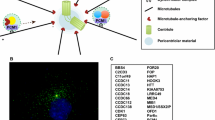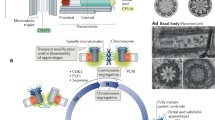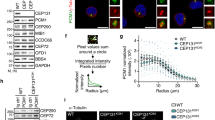Abstract
Centriolar satellites are small, microscopically visible granules that cluster around centrosomes. These structures, which contain numerous proteins directly involved in centrosome maintenance, ciliogenesis, and neurogenesis, have traditionally been viewed as vehicles for protein trafficking towards the centrosome. However, the recent identification of several new centriolar satellite components suggests that this model offers only an incomplete picture of their cellular functions. While the mechanisms controlling centriolar satellite status and function are not yet understood in detail, emerging evidence points to these structures as important hubs for dynamic, multi-faceted regulation in response to a variety of cues. In this review, we summarize the current knowledge of the roles of centriolar satellites in regulating centrosome functions, ciliogenesis, and neurogenesis. We also highlight newly discovered regulatory mechanisms targeting centriolar satellites and their functional status, and we discuss how defects in centriolar satellite components are intimately linked to a wide spectrum of human diseases.




Similar content being viewed by others
References
Balczon R, Bao L, Zimmer WE (1994) PCM-1, A 228-kD centrosome autoantigen with a distinct cell cycle distribution. J Cell Biol 124:783–793
Kubo A, Sasaki H, Yuba-Kubo A et al (1999) Centriolar satellites: molecular characterization, ATP-dependent movement toward centrioles and possible involvement in ciliogenesis. J Cell Biol 147:969–980
Kubo A, Tsukita S (2003) Non-membranous granular organelle consisting of PCM-1: subcellular distribution and cell-cycle-dependent assembly/disassembly. J Cell Sci 116:919–928
Dammermann A, Merdes A (2002) Assembly of centrosomal proteins and microtubule organization depends on PCM-1. J Cell Biol 159:255–266. doi:10.1083/jcb.200204023
Bernhard W, de Harven E (1960) L’ultrastructure du centriole et d’autres éléments de l’appareil achromatique. In: Bargmann W, Peters D, Wolpers C (eds) Verhandlungen Band II/Biologisch-Medizinischer Teil. Springer Berlin Heidelberg, pp 217–227
Nigg EA, Raff JW (2009) Centrioles, centrosomes, and cilia in health and disease. Cell 139:663–678. doi:10.1016/j.cell.2009.10.036
Doxsey S, Zimmerman W, Mikule K (2005) Centrosome control of the cell cycle. Trends Cell Biol 15:303–311. doi:10.1016/j.tcb.2005.04.008
Ishikawa H, Marshall WF (2011) Ciliogenesis: building the cell’s antenna. Nat Rev Mol Cell Biol 12:222–234. doi:10.1038/nrm3085
Bärenz F, Mayilo D, Gruss OJ (2011) Centriolar satellites: busy orbits around the centrosome. Eur J Cell Biol 90:983–989. doi:10.1016/j.ejcb.2011.07.007
Lopes CAM, Prosser SL, Romio L et al (2011) Centriolar satellites are assembly points for proteins implicated in human ciliopathies, including oral-facial-digital syndrome 1. J Cell Sci 124:600–612. doi:10.1242/jcs.077156
Engelender S, Sharp AH, Colomer V et al (1997) Huntingtin-associated protein 1 (HAP1) interacts with the p150Glued subunit of dynactin. Hum Mol Genet 6:2205–2212
Wang G, Chen Q, Zhang X et al (2013) PCM1 recruits Plk1 to the pericentriolar matrix to promote primary cilia disassembly before mitotic entry. J Cell Sci 126:1355–1365. doi:10.1242/jcs.114918
Kamiya A, Tan PL, Kubo K-I et al (2008) Recruitment of PCM1 to the centrosome by the cooperative action of DISC1 and BBS4: a candidate for psychiatric illnesses. Arch Gen Psychiatry 65:996–1006. doi:10.1001/archpsyc.65.9.996
Graser S, Stierhof Y-D, Lavoie SB et al (2007) Cep164, a novel centriole appendage protein required for primary cilium formation. J Cell Biol 179:321–330. doi:10.1083/jcb.200707181
Kim K, Rhee K (2011) The pericentriolar satellite protein CEP90 is crucial for integrity of the mitotic spindle pole. J Cell Sci 124:338–347. doi:10.1242/jcs.078329
Hori A, Ikebe C, Tada M, Toda T (2014) Msd1/SSX2IP-dependent microtubule anchorage ensures spindle orientation and primary cilia formation. EMBO Rep. doi:10.1002/embr.201337929
Srsen V, Gnadt N, Dammermann A, Merdes A (2006) Inhibition of centrosome protein assembly leads to p53-dependent exit from the cell cycle. J Cell Biol 174:625–630. doi:10.1083/jcb.200606051
Bärenz F, Inoue D, Yokoyama H et al (2013) The centriolar satellite protein SSX2IP promotes centrosome maturation. J Cell Biol 202:81–95. doi:10.1083/jcb.201302122
Puram SV, Kim AH, Ikeuchi Y et al (2011) A CaMKIIβ signaling pathway at the centrosome regulates dendrite patterning in the brain. Nat Neurosci 14:973–983. doi:10.1038/nn.2857
Ge XX, Frank CLC, de Anda FFC, Tsai L-HL (2010) Hook3 interacts with PCM1 to regulate pericentriolar material assembly and the timing of neurogenesis. Neuron 65:13. doi:10.1016/j.neuron.2010.01.011
Piel M, Meyer P, Khodjakov A et al (2000) The respective contributions of the mother and daughter centrioles to centrosome activity and behavior in vertebrate cells. J Cell Biol 149:317–330
Li Q, Hansen D, Killilea A et al (2001) Kendrin/pericentrin-B, a centrosome protein with homology to pericentrin that complexes with PCM-1. J Cell Sci 114:797–809
Young A, Dictenberg JB, Purohit A et al (2000) Cytoplasmic dynein-mediated assembly of pericentrin and gamma tubulin onto centrosomes. Mol Biol Cell 11:2047–2056
Kim JC, Badano JL, Sibold S et al (2004) The Bardet-Biedl protein BBS4 targets cargo to the pericentriolar region and is required for microtubule anchoring and cell cycle progression. Nat Genet 36:462–470. doi:10.1038/ng1352
Kodani A, Tonthat V, Wu B, Sütterlin C (2010) Par6 alpha interacts with the dynactin subunit p150 Glued and is a critical regulator of centrosomal protein recruitment. Mol Biol Cell 21:3376–3385. doi:10.1091/mbc.E10-05-0430
Kim J, Krishnaswami SR, Gleeson JG (2008) CEP290 interacts with the centriolar satellite component PCM-1 and is required for Rab8 localization to the primary cilium. Hum Mol Genet 17:3796–3805. doi:10.1093/hmg/ddn277
Hames RSR, Crookes RER, Straatman KRK et al (2005) Dynamic recruitment of Nek2 kinase to the centrosome involves microtubules, PCM-1, and localized proteasomal degradation. Mol Biol Cell 16:1711–1724. doi:10.1091/mbc.E04-08-0688
Oshimori N, Li X, Ohsugi M, Yamamoto T (2009) Cep72 regulates the localization of key centrosomal proteins and proper bipolar spindle formation. EMBO J 28:2066–2076. doi:10.1038/emboj.2009.161
Stowe TR, Wilkinson CJ, Iqbal A, Stearns T (2012) The centriolar satellite proteins Cep72 and Cep290 interact and are required for recruitment of BBS proteins to the cilium. Mol Biol Cell 23:3322–3335. doi:10.1091/mbc.E12-02-0134
Piehl M, Tulu US, Wadsworth P, Cassimeris L (2004) Centrosome maturation: measurement of microtubule nucleation throughout the cell cycle by using GFP-tagged EB1. Proc Natl Acad Sci USA 101:1584–1588. doi:10.1073/pnas.0308205100
Avidor-Reiss T, Gopalakrishnan J (2013) Building a centriole. Curr Opin Cell Biol 25:72–77. doi:10.1016/j.ceb.2012.10.016
Doxsey S (2001) Re-evaluating centrosome function. Nat Rev Mol Cell Biol 2:688–698. doi:10.1038/35089575
Blagden SP, Glover DM (2003) Polar expeditions–provisioning the centrosome for mitosis. Nat Cell Biol 5:505–511. doi:10.1038/ncb0603-505
Staples CJ, Myers KN, Beveridge RDD et al (2012) The centriolar satellite protein Cep131 is important for genome stability. J Cell Sci 125:4770–4779. doi:10.1242/jcs.104059
Staples CJ, Myers KN, Beveridge RDD et al (2014) Ccdc13; a novel human centriolar satellite protein required for ciliogenesis and genome stability. J Cell Sci. doi:10.1242/jcs.147785
Nachury MV, Loktev AV, Zhang Q et al (2007) A core complex of BBS proteins cooperates with the GTPase Rab8 to promote ciliary membrane biogenesis. Cell 129:1201–1213. doi:10.1016/j.cell.2007.03.053
Chamling X, Seo S, Searby CC et al (2014) The centriolar satellite protein AZI1 interacts with BBS4 and regulates ciliary trafficking of the BBSome. PLoS Genet 10:e1004083. doi:10.1371/journal.pgen.1004083
Kim K, Lee K, Rhee K (2012) CEP90 is required for the assembly and centrosomal accumulation of centriolar satellites, which is essential for primary cilia formation. PLoS One 7:e48196. doi:10.1371/journal.pone.0048196
Oshimori N, Ohsugi M, Yamamoto T (2006) The Plk1 target Kizuna stabilizes mitotic centrosomes to ensure spindle bipolarity. Nat Cell Biol 8:1095–1101. doi:10.1038/ncb1474
Kimura M, Yoshioka T, Saio M et al (2013) Mitotic catastrophe and cell death induced by depletion of centrosomal proteins. Cell Death Dis 4:e603. doi:10.1038/cddis.2013.108
Vladar EK, Stearns T (2007) Molecular characterization of centriole assembly in ciliated epithelial cells. J Cell Biol 178:31–42. doi:10.1083/jcb.200703064
Ye X, Zeng H, Ning G et al (2014) C2cd3 is critical for centriolar distal appendage assembly and ciliary vesicle docking in mammals. Proc Natl Acad Sci USA. doi:10.1073/pnas.1318737111
Hames RS, Fry AM (2002) Alternative splice variants of the human centrosome kinase Nek2 exhibit distinct patterns of expression in mitosis. Biochem J 361:77–85
Lacey KR, Jackson PK, Stearns T (1999) Cyclin-dependent kinase control of centrosome duplication. Proc Natl Acad Sci USA 96:2817–2822
Krämer A, Mailand N, Lukas C et al (2004) Centrosome-associated Chk1 prevents premature activation of cyclin-B-Cdk1 kinase. Nat Cell Biol 6:884–891. doi:10.1038/ncb1165
Brown NJ, Marjanović M, Lüders J et al (2013) Cep63 and cep152 cooperate to ensure centriole duplication. PLoS One 8:e69986. doi:10.1371/journal.pone.0069986
Firat-Karalar EN, Rauniyar N, Yates JR, Stearns T (2014) Proximity interactions among centrosome components identify regulators of centriole duplication. Curr Biol 24:664–670. doi:10.1016/j.cub.2014.01.067
Mikule K, Delaval B, Kaldis P et al (2007) Loss of centrosome integrity induces p38-p53-p21-dependent G1-S arrest. Nat Cell Biol 9:160–170
Goetz SC, Anderson KV (2010) The primary cilium: a signalling centre during vertebrate development. Nat Rev Genet 11:331–344. doi:10.1038/nrg2774
Babu D, Roy S (2013) Left-right asymmetry: cilia stir up new surprises in the node. Open Biol 3:130052. doi:10.1098/rsob.130052
Ansley SJ, Badano JL, Blacque OE et al (2003) Basal body dysfunction is a likely cause of pleiotropic Bardet-Biedl syndrome. Nature 425:628–633. doi:10.1038/nature02030
Tsang WY, Bossard C, Khanna H et al (2008) CP110 suppresses primary cilia formation through its interaction with CEP290, a protein deficient in human ciliary disease. Dev Cell 15:187–197. doi:10.1016/j.devcel.2008.07.004
Goetz SC, Liem KF, Anderson KV (2012) The spinocerebellar ataxia-associated gene Tau tubulin kinase 2 controls the initiation of ciliogenesis. Cell 151:847–858. doi:10.1016/j.cell.2012.10.010
Pedersen LB, Rosenbaum JL (2008) Intraflagellar transport (IFT) role in ciliary assembly, resorption and signalling. Curr Top Dev Biol 85:23–61. doi:10.1016/S0070-2153(08)00802-8
Jin H, White SR, Shida T et al (2010) The conserved Bardet-Biedl syndrome proteins assemble a coat that traffics membrane proteins to cilia. Cell 141:1208–1219. doi:10.1016/j.cell.2010.05.015
Tadenev ALD, Kulaga HM, May-Simera HL et al (2011) Loss of Bardet-Biedl syndrome protein-8 (BBS8) perturbs olfactory function, protein localization, and axon targeting. Proc Natl Acad Sci USA 108:10320–10325. doi:10.1073/pnas.1016531108
Tan PL, Barr T, Inglis PN et al (2007) Loss of Bardet Biedl syndrome proteins causes defects in peripheral sensory innervation and function. Proc Natl Acad Sci USA 104:17524–17529. doi:10.1073/pnas.0706618104
Kulaga HM, Leitch CC, Eichers ER et al (2004) Loss of BBS proteins causes anosmia in humans and defects in olfactory cilia structure and function in the mouse. Nat Genet 36:994–998. doi:10.1038/ng1418
Eichers ER, Abd-El-Barr MM, Paylor R et al (2006) Phenotypic characterization of Bbs4 null mice reveals age-dependent penetrance and variable expressivity. Hum Genet 120:211–226. doi:10.1007/s00439-006-0197-y
Coppieters F, Lefever S, Leroy BP, De Baere E (2010) CEP290, a gene with many faces: mutation overview and presentation of CEP290base. Hum Mutat 31:1097–1108. doi:10.1002/humu.21337
Fattahi Z, Rostami P, Najmabadi A et al (2014) Mutation profile of BBS genes in Iranian patients with Bardet-Biedl syndrome: genetic characterization and report of nine novel mutations in five BBS genes. J Hum Genet. doi:10.1038/jhg.2014.28
Zhang Q, Yu D, Seo S et al (2012) Intrinsic protein–protein interaction-mediated and chaperonin-assisted sequential assembly of stable Bardet-Biedl syndrome protein complex, the BBSome. J Biol Chem 287:20625–20635. doi:10.1074/jbc.M112.341487
Zhang Y, Seo S, Bhattarai S et al (2014) BBS mutations modify phenotypic expression of CEP290-related ciliopathies. Hum Mol Genet 23:40–51. doi:10.1093/hmg/ddt394
Wilkinson CJ, Carl M, Harris WA (2009) Cep70 and Cep131 contribute to ciliogenesis in zebrafish embryos. BMC Cell Biol 10:17. doi:10.1186/1471-2121-10-17
Ma L, Jarman AP (2011) Dilatory is a drosophila protein related to AZI1 (CEP131) that is located at the ciliary base and required for cilium formation. J Cell Sci 124:2622–2630. doi:10.1242/jcs.084798
Hall EA, Keighren M, Ford MJ et al (2013) Acute versus chronic loss of mammalian azi1/cep131 results in distinct ciliary phenotypes. PLoS Genet 9:e1003928. doi:10.1371/journal.pgen.1003928
Akimov V, Rigbolt KTG, Nielsen MM, Blagoev B (2011) Characterization of ubiquitination dependent dynamics in growth factor receptor signaling by quantitative proteomics. Mol BioSyst 7:3223–3233. doi:10.1039/c1mb05185g
Villumsen BH, Danielsen JR, Povlsen L et al (2013) A new cellular stress response that triggers centriolar satellite reorganization and ciliogenesis. EMBO J. doi:10.1038/emboj.2013.223
Chavali PL, Gergely F (2013) Cilia born out of shock and stress. EMBO J 32:3011–3013. doi:10.1038/emboj.2013.241
Tang Z, Lin MG, Stowe TR et al (2013) Autophagy promotes primary ciliogenesis by removing OFD1 from centriolar satellites. Nature. doi:10.1038/nature12606
Romio L, Fry AM, Winyard PJD et al (2004) OFD1 is a centrosomal/basal body protein expressed during mesenchymal-epithelial transition in human nephrogenesis. J Am Soc Nephrol 15:2556–2568. doi:10.1097/01.ASN.0000140220.46477.5C
Singla V, Romaguera-Ros M, Garcia-Verdugo JM, Reiter JF (2010) Ofd1, a human disease gene, regulates the length and distal structure of centrioles. Dev Cell 18:410–424. doi:10.1016/j.devcel.2009.12.022
Ferrante MI, Zullo A, Barra A et al (2006) Oral-facial-digital type I protein is required for primary cilia formation and left-right axis specification. Nat Genet 38:112–117. doi:10.1038/ng1684
Coene KLM, Roepman R, Doherty D et al (2009) OFD1 is mutated in X-linked Joubert syndrome and interacts with LCA5-encoded lebercilin. Am J Hum Genet 85:465–481. doi:10.1016/j.ajhg.2009.09.002
Pampliega O, Orhon I, Patel B et al (2013) Functional interaction between autophagy and ciliogenesis. Nature 502:194–200. doi:10.1038/nature12639
McEwen DP, Koenekoop RK, Khanna H et al (2007) Hypomorphic CEP290/NPHP6 mutations result in anosmia caused by the selective loss of G proteins in cilia of olfactory sensory neurons. Proc Natl Acad Sci USA 104:15917–15922. doi:10.1073/pnas.0704140104
Craige B, Tsao C-C, Diener DR et al (2010) CEP290 tethers flagellar transition zone microtubules to the membrane and regulates flagellar protein content. J Cell Biol 190:927–940. doi:10.1083/jcb.201006105
Kobayashi T, Kim S, Lin Y-C et al (2014) The CP110-interacting proteins Talpid3 and Cep290 play overlapping and distinct roles in cilia assembly. J Cell Biol. doi:10.1083/jcb.201304153
Zerial M, McBride H (2001) Rab proteins as membrane organizers. Nat Rev Mol Cell Biol 2:107–117. doi:10.1038/35052055
Nachury MV, Seeley ES, Jin H (2010) Trafficking to the ciliary membrane: how to get across the periciliary diffusion barrier? Annu Rev Cell Dev Biol 26:59–87. doi:10.1146/annurev.cellbio.042308.113337
Chang BB, Khanna HH, Hawes NN et al (2006) In-frame deletion in a novel centrosomal/ciliary protein CEP290/NPHP6 perturbs its interaction with RPGR and results in early-onset retinal degeneration in the rd16 mouse. Hum Mol Genet 15:1847–1857. doi:10.1093/hmg/ddl107
Chen Z, Indjeian VB, McManus M et al (2002) CP110, a cell cycle-dependent CDK substrate, regulates centrosome duplication in human cells. Dev Cell 3:339–350
Spektor A, Tsang WY, Khoo D, Dynlacht BD (2007) Cep97 and CP110 suppress a cilia assembly program. Cell 130:678–690. doi:10.1016/j.cell.2007.06.027
Tsang WY, Dynlacht BD (2013) CP110 and its network of partners coordinately regulate cilia assembly. Cilia 2:9. doi:10.1186/2046-2530-2-9
Pugacheva EN, Jablonski SA, Hartman TR et al (2007) HEF1-dependent Aurora A activation induces disassembly of the primary cilium. Cell 129:1351–1363. doi:10.1016/j.cell.2007.04.035
Lee JY, Stearns T (2013) FOP is a centriolar satellite protein involved in ciliogenesis. PLoS One 8:e58589. doi:10.1371/journal.pone.0058589
Sedjaï F, Acquaviva C, Chevrier V et al (2010) Control of ciliogenesis by FOR20, a novel centrosome and pericentriolar satellite protein. J Cell Sci 123:2391–2401. doi:10.1242/jcs.065045
Klinger M, Wang W, Kuhns S et al (2013) The novel centriolar satellite protein SSX2IP targets Cep290 to the ciliary transition zone. Mol Biol Cell. doi:10.1091/mbc.E13-09-0526
Keryer G, Pineda JR, Liot G et al (2011) Ciliogenesis is regulated by a huntingtin-HAP1-PCM1 pathway and is altered in Huntington disease. J Clin Invest 121:4372–4382. doi:10.1172/JCI57552
Porteous DJ, Thomson P, Brandon NJ, Millar JK (2006) The genetics and biology of DISC1–an emerging role in psychosis and cognition. Biol Psychiatry 60:123–131. doi:10.1016/j.biopsych.2006.04.008
Park N, Juo SH, Cheng R et al (2004) Linkage analysis of psychosis in bipolar pedigrees suggests novel putative loci for bipolar disorder and shared susceptibility with schizophrenia. Mol Psychiatry 9:1091–1099. doi:10.1038/sj.mp.4001541
Puram SV, Riccio A, Koirala S et al (2011) A TRPC5-regulated calcium signaling pathway controls dendrite patterning in the mammalian brain. Genes Dev 25:2659–2673. doi:10.1101/gad.174060.111
Lazic SE, Goodman AOG, Grote HE et al (2007) Olfactory abnormalities in Huntington’s disease: decreased plasticity in the primary olfactory cortex of R6/1 transgenic mice and reduced olfactory discrimination in patients. Brain Res 1151:219–226. doi:10.1016/j.brainres.2007.03.018
Liu J-P, Zeitlin SO (2011) The long and the short of aberrant ciliogenesis in Huntington disease. J Clin Invest 121:4237–4241. doi:10.1172/JCI60243
Spalluto C, Wilson DI, Hearn T (2013) Evidence for centriolar satellite localization of CDK1 and cyclin B2. Cell Cycle 12:1802–1803
Olsen JV, Vermeulen M, Santamaria A et al (2010) Quantitative phosphoproteomics reveals widespread full phosphorylation site occupancy during mitosis. Sci Signal 3:ra3. doi:10.1126/scisignal.2000475
Prosser SL, Straatman KR, Fry AM (2009) Molecular dissection of the centrosome overduplication pathway in S-phase-arrested cells. Mol Cell Biol 29:1760–1773. doi:10.1128/MCB.01124-08
Löffler H, Fechter A, Liu FY et al (2012) DNA damage-induced centrosome amplification occurs via excessive formation of centriolar satellites. Oncogene. doi:10.1038/onc.2012.310
Pihan GA, Wallace J, Zhou Y, Doxsey SJ (2003) Centrosome abnormalities and chromosome instability occur together in pre-invasive carcinomas. Cancer Res 63:1398–1404
Dodson H, Bourke E, Jeffers LJ et al (2004) Centrosome amplification induced by DNA damage occurs during a prolonged G2 phase and involves ATM. EMBO J 23:3864–3873. doi:10.1038/sj.emboj.7600393
Franceschini A, Szklarczyk D, Frankild S et al (2013) STRING v9.1: protein–protein interaction networks, with increased coverage and integration. Nucleic Acids Res 41:D808–D815. doi:10.1093/nar/gks1094
Acknowledgments
Work in the laboratory of the authors is funded by the Novo Nordisk Foundation, Danish Medical Research Council, the Danish Cancer Society, and the Lundbeck Foundation.
Conflict of interest
The authors declare no conflict of interest.
Author information
Authors and Affiliations
Corresponding authors
Rights and permissions
About this article
Cite this article
Tollenaere, M.A.X., Mailand, N. & Bekker-Jensen, S. Centriolar satellites: key mediators of centrosome functions. Cell. Mol. Life Sci. 72, 11–23 (2015). https://doi.org/10.1007/s00018-014-1711-3
Received:
Revised:
Accepted:
Published:
Issue Date:
DOI: https://doi.org/10.1007/s00018-014-1711-3




